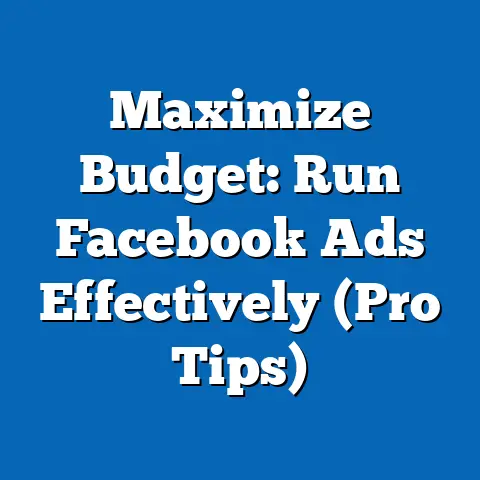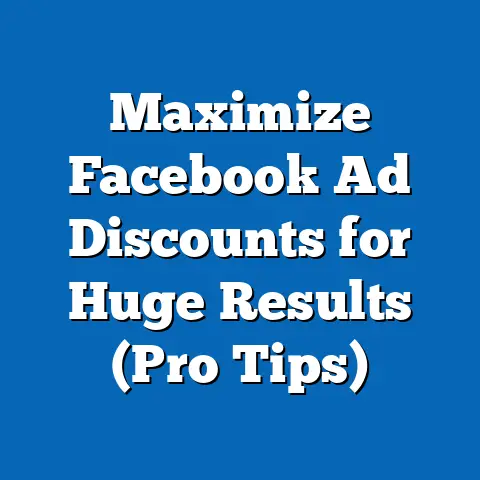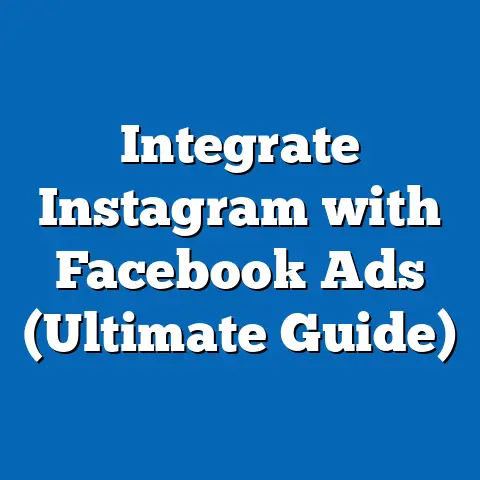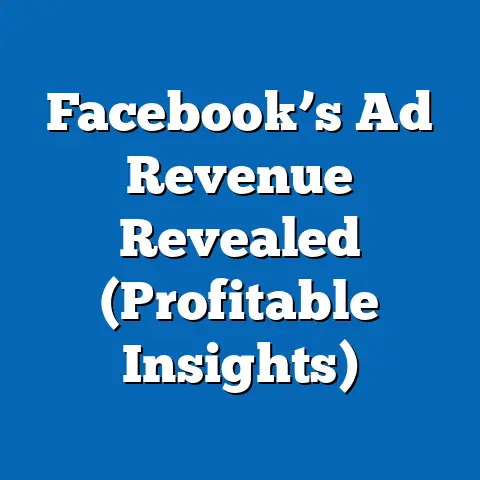Revamp Facebook Ads Strategy for 2025 (Next-Level Insights)
I remember the first time I truly understood the power of Facebook ads. It was 2016, and I was helping a local bakery run a campaign. We created a simple ad featuring a photo of their signature chocolate cake, targeted to people within a 5-mile radius who liked baking or desserts. The results were astounding – foot traffic to the bakery increased by 30% within the first week! It was a lightbulb moment.
But the world of Facebook ads has changed dramatically since then. Algorithms have become more complex, user privacy is paramount, and new ad formats are constantly emerging. The strategies that worked in 2016, or even 2020, simply won’t cut it in 2025. That’s why it’s absolutely crucial for businesses of all sizes to start rethinking their approach to Facebook advertising now.
This article isn’t just about updating your tactics; it’s about fundamentally shifting your mindset to stay ahead of the curve. I’ll be diving deep into the key trends, strategies, and best practices that will define Facebook advertising in 2025 and beyond. Get ready to revamp your approach and unlock next-level results!
The Current Landscape of Facebook Advertising (2023-2024)
Before we can look forward, we need to understand where we are now. The Facebook advertising landscape in 2023 and 2024 is a complex and ever-evolving ecosystem. Let’s take a look at some key statistics and trends:
- User Engagement: Facebook remains a dominant force, with over 3 billion monthly active users globally. While growth in some regions has slowed, the platform still commands a massive audience, making it a prime advertising channel. However, user attention is increasingly fragmented across multiple platforms, requiring advertisers to be more strategic in capturing their attention.
- Ad Performance: Ad spend on Facebook continues to rise, but the cost of reaching users is also increasing. This means that advertisers need to be more efficient and effective with their campaigns to achieve a positive ROI. According to Statista, the average cost-per-click (CPC) on Facebook ads in Q1 2024 was around $0.50 – $2.00, depending on the industry and targeting. This highlights the importance of optimizing ad creative, targeting, and bidding strategies to minimize costs.
- Marketplace Trends: Video advertising is booming, with more businesses investing in short-form videos, live streams, and interactive content. Mobile advertising continues to be the dominant format, as users spend the majority of their time on the platform via their smartphones. E-commerce integration is also becoming increasingly prevalent, with Facebook Shops and other features enabling businesses to sell directly to customers on the platform.
- Impact of Privacy Changes: Apple’s App Tracking Transparency (ATT) framework, introduced in 2021, has had a significant impact on Facebook’s ability to track user behavior and deliver personalized ads. This has led to a decrease in the accuracy of targeting and attribution, making it more challenging for advertisers to measure the true impact of their campaigns. As a result, businesses need to rely more on first-party data, contextual targeting, and creative optimization to reach their target audiences.
- Evolving Audience Demographics and Behaviors: The user base on Facebook is becoming more diverse, with a growing number of older adults and users from emerging markets. User behaviors are also changing, with more people using the platform to connect with communities, discover new products, and engage with brands. Advertisers need to understand these demographic and behavioral shifts to tailor their messaging and targeting strategies effectively.
Key Takeaway: The Facebook advertising landscape is dynamic and competitive. Advertisers need to stay informed about the latest trends, adapt to changes in user privacy policies, and understand the evolving audience demographics and behaviors to succeed.
Key Trends Shaping Facebook Advertising for 2025
Looking ahead to 2025, several key trends will significantly impact the future of Facebook advertising. Understanding and embracing these trends is essential for staying ahead of the competition and maximizing your ROI.
1. AI and Machine Learning: The Rise of Hyper-Personalization
Artificial intelligence (AI) and machine learning (ML) are already transforming the way we advertise on Facebook, and their influence will only grow stronger in the coming years. In 2025, AI will power more sophisticated ad targeting, creative optimization, and bidding strategies, enabling businesses to deliver hyper-personalized experiences to their target audiences.
- AI-Powered Targeting: AI algorithms will analyze vast amounts of data to identify the most relevant users for your ads, based on their demographics, interests, behaviors, and purchase history. This will enable you to reach highly specific segments of your target audience with tailored messaging.
- Dynamic Creative Optimization (DCO): DCO uses AI to automatically generate different versions of your ads, testing various combinations of headlines, images, and calls-to-action to identify the most effective creative elements. This ensures that your ads are always optimized for maximum engagement and conversion rates. I’ve seen campaigns where DCO improved click-through rates by as much as 40%.
- Automated Bidding: AI algorithms will analyze real-time data to automatically adjust your bids based on the likelihood of conversion. This will help you maximize your ROI by ensuring that you’re only paying for the most valuable clicks.
- Predictive Analytics: AI can analyze historical data to predict future trends and identify potential opportunities for your advertising campaigns. This will enable you to proactively adjust your strategies and stay ahead of the competition.
Example: Imagine you’re advertising a new line of organic skincare products. In 2025, AI could identify users who have shown interest in organic products, skincare, and healthy living. It could then generate different ad variations featuring different product benefits and testimonials, testing which resonates best with each user segment. Finally, it could automatically adjust your bids to prioritize users who are most likely to purchase your products.
Key Takeaway: Embrace AI and machine learning to unlock the power of hyper-personalization in your Facebook advertising campaigns. Experiment with DCO, automated bidding, and predictive analytics to optimize your ad performance and maximize your ROI.
2. Video Content Dominance: Short, Sweet, and Engaging
Video has been a dominant force in digital marketing for years, and its importance will only continue to grow in 2025. However, the type of video content that resonates with audiences is evolving. Short-form videos, live streams, and interactive content are becoming increasingly popular, capturing user attention and driving engagement.
- Short-Form Videos: Platforms like TikTok and Instagram Reels have popularized short-form videos, and Facebook is following suit. These bite-sized videos are perfect for capturing user attention quickly and delivering concise, impactful messages.
- Live Streams: Live video allows you to connect with your audience in real-time, building trust and fostering a sense of community. Use live streams to host Q&A sessions, product demonstrations, or behind-the-scenes glimpses into your business.
- Interactive Content: Interactive video formats, such as quizzes, polls, and clickable hotspots, can significantly boost user engagement. These formats encourage users to actively participate with your content, making it more memorable and impactful.
Example: Let’s say you’re a fitness brand promoting a new workout program. Instead of creating a long, polished video, you could create a series of short-form videos showcasing different exercises from the program. You could also host a live stream with a fitness instructor answering user questions about the program. Finally, you could create an interactive video quiz asking users to identify their fitness goals and recommending the best workout plan for them.
Key Takeaway: Embrace video content in your Facebook advertising strategy, focusing on short-form videos, live streams, and interactive formats. Create videos that are engaging, informative, and relevant to your target audience.
3. Augmented Reality (AR) Ads: Immersive Experiences
Augmented Reality (AR) is poised to revolutionize the way we interact with brands and products online. In 2025, AR ads will become more prevalent on Facebook, allowing users to virtually try on clothes, visualize furniture in their homes, and experience products in a whole new way.
- Virtual Try-On: AR allows users to virtually try on clothes, makeup, and accessories before making a purchase. This can significantly reduce returns and increase customer satisfaction.
- Product Visualization: AR enables users to visualize furniture, appliances, and other products in their homes before buying them. This can help them make more informed decisions and reduce the risk of buyer’s remorse.
- Interactive Games: AR can be used to create interactive games that promote your brand and products. This can be a fun and engaging way to capture user attention and drive brand awareness.
Example: Imagine you’re selling eyeglasses online. Instead of simply showing pictures of your glasses, you could use AR to allow users to virtually try them on using their smartphone camera. This would give them a much better sense of how the glasses look on their face and increase their confidence in making a purchase.
Key Takeaway: Explore the potential of AR ads to create immersive and engaging experiences for your target audience. Consider how you can use AR to allow users to virtually try on your products, visualize them in their homes, or interact with them in a fun and engaging way.
4. Sustainability and Ethical Marketing: Values-Driven Advertising
Consumers are increasingly concerned about sustainability and ethical business practices. In 2025, brands that emphasize their commitment to these values in their advertising will have a significant advantage.
- Transparency: Be transparent about your company’s sustainability efforts, ethical sourcing practices, and social impact initiatives.
- Authenticity: Don’t just talk the talk; walk the walk. Back up your claims with concrete actions and evidence.
- Storytelling: Share stories about the positive impact your business is having on the environment and society.
Example: Let’s say you’re a clothing brand that uses sustainable materials and ethical manufacturing practices. Instead of just focusing on the style and design of your clothes, you could create ads that highlight your commitment to sustainability and ethical production. You could share stories about the farmers who grow your cotton, the workers who sew your garments, and the positive impact your business is having on the environment.
Key Takeaway: Embrace sustainability and ethical marketing in your Facebook advertising strategy. Highlight your company’s commitment to these values in your messaging and showcase the positive impact your business is having on the environment and society.
5. Community Building and Social Commerce: Turning Engagement into Sales
Facebook is increasingly becoming a platform for community building and social commerce. In 2025, businesses that can create thriving communities around their brands and seamlessly integrate social commerce into their advertising strategies will thrive.
- Facebook Groups: Create Facebook groups to connect with your customers, foster a sense of community, and provide valuable content.
- Facebook Shops: Use Facebook Shops to sell your products directly to customers on the platform.
- Influencer Marketing: Partner with influencers to reach new audiences and promote your products.
Example: Let’s say you’re a coffee brand. You could create a Facebook group for coffee lovers, where you share brewing tips, recipes, and stories about your coffee beans. You could also use Facebook Shops to sell your coffee beans directly to members of the group. Finally, you could partner with coffee influencers to promote your brand and products to their followers.
Key Takeaway: Focus on building communities around your brand on Facebook and seamlessly integrating social commerce into your advertising strategies. Use Facebook Groups, Facebook Shops, and influencer marketing to connect with your customers, foster a sense of community, and drive sales.
Crafting Next-Level Ads (2025 and Beyond)
Creating high-impact ads that resonate with audiences in 2025 requires a shift in mindset. It’s no longer enough to simply promote your products or services; you need to tell compelling stories, create visually stunning content, and offer real value to your target audience.
- Storytelling: People connect with stories, not just products. Use your ads to tell authentic brand narratives that resonate with your target audience’s values and emotions. Think about the why behind your business and how it connects to your customer’s lives.
- Ad Creative Elements: Pay close attention to the visual and textual elements of your ads. Use high-quality images and videos that capture attention and convey your message effectively. Write compelling copy that speaks to your target audience’s needs and desires.
- Calls-to-Action: Make it clear what you want your audience to do after seeing your ad. Use strong, action-oriented calls-to-action that encourage them to click, learn more, or make a purchase. Instead of a generic “Learn More,” try something more specific like “Get Your Free Guide” or “Shop the New Collection.”
- A/B Testing: Never assume you know what will work best. Continuously A/B test different ad variations to identify the most effective creative elements and messaging. Test everything from headlines and images to calls-to-action and targeting options.
- Data-Driven Decision-Making: Use data to inform your decisions and optimize your ad campaigns. Track key metrics like click-through rates, conversion rates, and cost-per-acquisition to identify what’s working and what’s not. Don’t be afraid to kill campaigns that aren’t performing well and focus on those that are driving results.
Personal Story: I once worked with a travel agency that was struggling to attract new customers. Their ads were generic and focused solely on promoting their travel packages. We decided to revamp their strategy and focus on storytelling. We created a series of ads featuring real customers sharing their travel experiences and highlighting the emotional benefits of travel. The results were dramatic – their click-through rates increased by 50% and their conversion rates tripled!
Key Takeaway: Craft next-level ads by focusing on storytelling, creating visually stunning content, and offering real value to your target audience. Continuously A/B test different ad variations and use data to inform your decisions and optimize your ad campaigns.
Targeting Strategies for 2025
Effective targeting is the cornerstone of any successful Facebook advertising campaign. In 2025, with increasing privacy regulations and evolving user behaviors, it’s more important than ever to leverage advanced targeting options to reach the right audience with the right message.
- Custom Audiences: Custom Audiences allow you to target users who have already interacted with your business, such as website visitors, email subscribers, or customers. This is a highly effective way to retarget users who are already familiar with your brand and more likely to convert. I’ve seen Custom Audiences consistently outperform broad targeting options in terms of conversion rates.
- Lookalike Audiences: Lookalike Audiences allow you to reach new users who are similar to your existing customers. Facebook analyzes the characteristics of your Custom Audiences and identifies other users who share similar demographics, interests, and behaviors. This is a great way to expand your reach and acquire new customers.
- Behavioral and Interest-Based Targeting: Facebook allows you to target users based on their interests, hobbies, and behaviors. This is a powerful way to reach users who are passionate about specific topics or actively engaged in certain activities. However, with increasing privacy regulations, it’s important to be mindful of how you’re using this data and ensure that you’re targeting users in a responsible and ethical manner.
- Retargeting Strategies: Retargeting is a crucial component of any successful Facebook advertising campaign. It allows you to reach users who have visited your website, viewed your products, or added items to their cart but haven’t yet made a purchase. Use retargeting to remind these users about your products and encourage them to complete their purchase.
Example: Let’s say you’re selling online courses. You could create a Custom Audience of users who have visited your website and viewed your course pages. Then, you could create a Lookalike Audience of users who are similar to those who have already purchased your courses. Finally, you could create retargeting ads that show users who have viewed your course pages but haven’t yet enrolled, reminding them about the benefits of your courses and offering them a special discount.
Key Takeaway: Leverage advanced targeting options like Custom Audiences, Lookalike Audiences, and behavioral targeting to reach the right audience with the right message. Use retargeting strategies to remind users about your products and encourage them to complete their purchase.
Measuring Success and ROI
Measuring the success of your Facebook ad campaigns is crucial for understanding what’s working and what’s not. In 2025, it’s more important than ever to set clear objectives and KPIs aligned with your business goals and track the metrics that matter most.
- Set Clear Objectives and KPIs: Before launching any Facebook ad campaign, define your objectives and KPIs. What do you want to achieve with your campaign? Do you want to increase brand awareness, generate leads, drive sales, or something else? Once you’ve defined your objectives, identify the KPIs that will help you measure your progress.
- Track Key Metrics: Track key metrics like click-through rates (CTR), conversion rates, cost-per-click (CPC), cost-per-acquisition (CPA), and return on ad spend (ROAS). These metrics will give you valuable insights into the performance of your campaigns and help you identify areas for improvement.
- Use Facebook’s Ads Manager: Facebook’s Ads Manager provides a wealth of data and analytics that you can use to track the performance of your campaigns. Use Ads Manager to monitor your metrics, analyze your results, and make informed adjustments to your strategies.
- Utilize Other Analytics Tools: In addition to Facebook’s Ads Manager, consider using other analytics tools like Google Analytics to track the performance of your Facebook ad campaigns. These tools can provide additional insights into user behavior and help you understand the overall impact of your advertising efforts.
Example: Let’s say you’re running a Facebook ad campaign to generate leads for your business. Your objective is to increase the number of leads you generate by 20% in the next month. Your KPIs are the number of leads generated, the cost-per-lead, and the conversion rate from lead to customer. You would track these metrics in Facebook’s Ads Manager and Google Analytics to monitor your progress and make adjustments to your campaign as needed.
Key Takeaway: Set clear objectives and KPIs aligned with your business goals and track the metrics that matter most. Use Facebook’s Ads Manager and other analytics tools to track your performance, analyze your results, and make informed adjustments to your strategies.
Preparing for Future Changes in Facebook Advertising
The world of digital marketing is constantly evolving, and Facebook advertising is no exception. To stay ahead of the curve in 2025 and beyond, it’s essential to stay adaptable and continuously learn.
- Stay Adaptable: Be prepared to adapt your strategies as Facebook’s algorithms, ad formats, and targeting options continue to evolve.
- Continuously Learn: Stay up-to-date on the latest trends and best practices in Facebook advertising by reading industry blogs, attending webinars, and taking online courses.
- Foster a Culture of Innovation: Encourage your marketing team to experiment with new ideas and approaches.
- Embrace Experimentation: Don’t be afraid to try new things and see what works.
Potential Future Challenges:
- Evolving Regulations: Privacy regulations are becoming increasingly strict, which could limit your ability to target users and track their behavior.
- Competition from Other Platforms: Other social media platforms like TikTok and Instagram are becoming increasingly popular, which could siphon away users from Facebook.
- Changes in Consumer Behavior: Consumer behavior is constantly evolving, and you need to stay on top of these changes to effectively reach your target audience.
Key Takeaway: Stay adaptable and continuously learn to prepare for future changes in Facebook advertising. Foster a culture of innovation and embrace experimentation to stay ahead of the curve.
Conclusion
As we approach 2025, it’s clear that the Facebook advertising landscape is poised for significant change. The trends I’ve outlined – the rise of AI, the dominance of video, the emergence of AR, the importance of sustainability, and the focus on community building – will all play a crucial role in shaping the future of advertising on the platform.
To succeed in this new environment, businesses need to revamp their Facebook ads strategy, embracing these trends and adapting their approaches to resonate with evolving user behaviors. By focusing on storytelling, creating visually stunning content, leveraging advanced targeting options, and measuring success with clear KPIs, you can unlock next-level results and achieve your business goals.
The future of advertising on social media is bright, but it requires a willingness to adapt, innovate, and experiment. Facebook will continue to be a powerful platform for reaching and engaging with your target audience, but only if you’re prepared to embrace the changes that are on the horizon.
The digital advertising world is ever-evolving, and Facebook is no exception. By embracing the changes and understanding the key trends, you can position yourself for success. Don’t be afraid to experiment, analyze your data, and adapt your strategies to stay ahead of the curve. The future of Facebook advertising is exciting, and I believe those who are willing to embrace the changes will be the ones who reap the rewards.
Call to Action
What are your thoughts on the future of Facebook advertising? What strategies do you plan to implement moving forward as you prepare for 2025? Share your thoughts in the comments below! I’d love to hear your perspectives and learn from your experiences. Let’s work together to shape the future of Facebook advertising!






